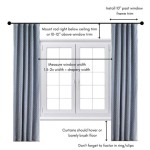How Many Inches From Ceiling To Hang Curtains
The placement of curtains significantly impacts a room's aesthetic appeal, perceived size, and overall ambiance. One critical element determining this impact is the height at which the curtains are hung. The distance between the ceiling and the curtain rod is a key factor in achieving a balanced and visually pleasing result. This distance is not arbitrary; it depends on several factors, including ceiling height, window size, curtain style, and the desired visual effect.
Calculating the correct distance from the ceiling to hang curtains involves considering several key principles of interior design. This article explores these principles in detail, providing guidance for determining the optimal hanging height for curtains in various settings.
Maximizing Ceiling Height: The Illusion of Space
One of the most common reasons for hanging curtains higher than the window frame is to create the illusion of greater ceiling height. When curtain rods are mounted closer to the ceiling, the curtains visually extend the height of the walls, making the room feel taller and more spacious. This technique is particularly effective in rooms with lower ceilings, where maximizing vertical space is crucial for creating a sense of openness.
The principles behind this illusion are rooted in visual perception. By drawing the eye upward towards the higher curtain rod, the brain interprets the wall as being taller than it actually is. This effect is further enhanced when using floor-to-ceiling curtains, as the uninterrupted vertical line from the floor to the top of the curtains reinforces the sense of height.
The recommended distance from the ceiling when attempting to maximize height is typically between 4 to 12 inches. However, the specific distance depends on the overall ceiling height. In rooms with standard 8-foot ceilings, hanging curtains 4 to 6 inches below the ceiling is generally sufficient to create a noticeable difference. In rooms with higher ceilings, such as 9 or 10 feet, the curtains can be hung even closer to the ceiling, up to 12 inches, to further amplify the effect.
It is important to consider the length of the curtains when determining the hanging height. Curtains that are too short will negate the effect of a higher rod placement, as they will create a visual break in the vertical line. Therefore, it is essential to choose curtains that are long enough to reach the floor or slightly puddle, depending on the desired aesthetic. Proper measurements are crucial to ensure the curtains hang correctly and achieve the intended visual impact.
Furthermore, the style of the curtain header can influence the perceived height. Curtains with pleats or grommets tend to hang lower than those with rod pockets, so this difference must be factored into the overall calculation. The hardware used, such as decorative finials, should also be considered, as they can add to the overall height and affect the final appearance.
When maximizing ceiling height, it is generally advisable to avoid hanging curtains at the same height as the window frame. This can make the window appear smaller and less prominent, defeating the purpose of enhancing the room's vertical dimensions. Instead, aim for a significant difference between the window frame and the curtain rod to create a more dramatic and impactful effect.
Window Size and Proportions: Balancing Visual Weight
The size and proportions of the windows in a room play a crucial role in determining the appropriate hanging height for curtains. The goal is to create a balanced and harmonious visual relationship between the window, the curtains, and the surrounding wall space. Hanging curtains too high or too low can disrupt this balance, resulting in an aesthetically unappealing outcome.
For smaller windows, hanging curtains closer to the ceiling can help to make the window appear larger and more prominent. By extending the curtains beyond the sides of the window frame, the window is visually expanded, creating a sense of greater size and importance. This technique is particularly useful in rooms with small windows that might otherwise feel cramped or enclosed.
When working with larger windows, the focus shifts to maintaining a sense of proportion and balance. While it is still possible to hang curtains higher than the window frame, it is important to avoid overwhelming the space. Hanging curtains too high above a large window can make the wall space above the window appear disproportionately small, creating an unbalanced and awkward appearance.
In the case of large windows, a more conservative approach may be warranted. Hanging curtains a few inches above the window frame, or even at the same height, can be a suitable option, particularly if the goal is to maintain a sense of symmetry and order. This approach can be especially effective in rooms with high ceilings, where the window already commands a significant presence.
The style of the curtains themselves can also influence the perceived size and proportions of the window. Heavy, ornate curtains can make a window appear smaller and more imposing, while lighter, more sheer curtains can create a sense of openness and airiness. Therefore, it is essential to consider the overall aesthetic of the curtains when determining the hanging height.
Furthermore, the architectural style of the room can play a role in determining the optimal hanging height for curtains. In rooms with traditional or formal architecture, a more conservative approach may be appropriate, while in rooms with modern or contemporary architecture, a more experimental approach may be considered.
Practical Considerations: Functionality and Accessibility
While aesthetic considerations are paramount, practical factors also play a significant role in determining the appropriate hanging height for curtains. Functionality and accessibility are essential considerations, particularly in rooms where the curtains are frequently opened and closed. The hanging height should allow for easy operation of the curtains without compromising their visual appeal.
One crucial practical consideration is the placement of the curtain rod brackets. The brackets must be securely mounted to the wall studs or with appropriate anchors to ensure that they can support the weight of the curtains. The distance between the brackets and the ceiling should be sufficient to allow for easy installation and removal of the curtains.
Accessibility is another important factor to consider. The hanging height should allow for easy access to the curtains for opening, closing, and maintenance. If the curtains are hung too high, it may be difficult to reach them without using a ladder or step stool, which can be inconvenient and potentially unsafe. Conversely, if the curtains are hung too low, they may drag on the floor or interfere with furniture, creating a tripping hazard.
The type of curtain rod and hardware used can also influence the practical considerations. Some curtain rods are designed to be mounted directly to the ceiling, while others require brackets that extend a certain distance from the wall. The design of the hardware should be taken into account when determining the hanging height to ensure that the curtains function properly and are easily accessible.
In addition to accessibility, consider the functionality of the curtains in terms of light control and privacy. The hanging height should be such that the curtains effectively block out light when closed and provide adequate privacy. If the curtains are not long enough or are not hung at the appropriate height, they may not be able to fully cover the window, allowing light to seep in and compromising privacy.
Finally, consider the presence of any obstacles that may affect the hanging height. For example, if there is a heating or cooling vent located above the window, it may be necessary to hang the curtains lower to avoid blocking the airflow. Similarly, if there is a built-in shelf or other architectural feature above the window, the hanging height may need to be adjusted to accommodate the obstruction.
In summary, determining the optimal distance from the ceiling to hang curtains is a nuanced process that involves balancing aesthetic considerations with practical factors. By carefully considering the principles of interior design, the size and proportions of the windows, and the functional requirements of the space, it is possible to achieve a visually pleasing and practical result. Proper planning and measurement are essential to ensure that the curtains hang correctly and achieve the intended effect, enhancing the overall appearance and functionality of the room.

Hanging Curtains You Re Probably Doing It Wrong Ask The Expert Style Boston Com Real Estate

How To Hang Curtains Look Their Best The Shade

How To Hang Curtains Like A Pro Diy Darling

How To Hang Curtains Simple Tips For A Bigger And Brighter Room

How To Hang Curtains Properly Interior Design Made Easy Chalking Up Success

How To Hang Curtains With Crown Molding The Shade

5 Tips On How To Hang Curtains Accounting For Design

How High To Hang Curtains Collected Living Design
How To Hang Curtains In 7 Steps

Linen Curtains Panels Custom White Grey Cream Pink Blue Stripe Chevron 80 Colors Size Made Etsy








